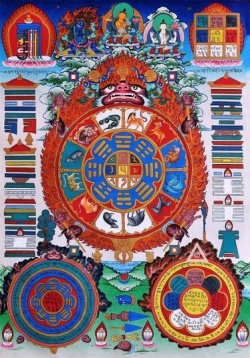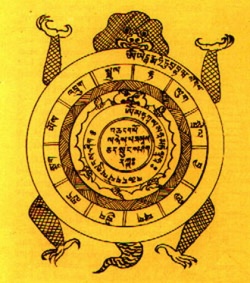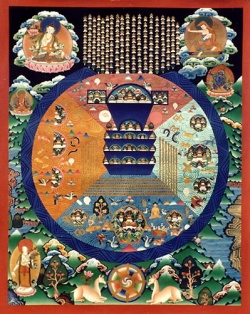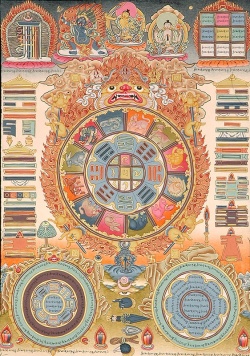The Tibetan calendar
INTRODUCTION
The Tibetan calendar is based on the cycles of the moon, and various dates are considered especially auspicious or inauspicious for certain practices. The information to collate this page is mainly taken from the sources mentioned at the bottom of this page.
Also some of the most important days of the Theravada tradition are included: over the centuries, a difference of one month has developed with the Tibetan tradition.
Please note that several aspects of the advised practice may differ in the various traditions. For example in addition to others, my teacher Lama Zopa Rinpoche advises his students to:
- Take "One-day Mahayana precepts" on all Buddha-days (see below).
- On tsog-days, he advises the "Guru puja" being done in his centers and "Those who have received an initiation into Highest Yoga Tantra have a commitment on the Tibetan 10th and 25th of every month to perform a tsog offering. The 10th is associated with Father Tantra and the 25th with Mother Tantra."
- On Medicine Buddha day (8th), he advises the practice of Tara and Mahakala
Especially in the Nyingma tradition, emphasis is put on the "Guru Rinpoche day" on the 10th of every month. In this way, all traditions celebrate their own special days in their own special way.
The multiplication factors mentioned below for special days can vary per tradition, if not mentioned otherwise, below follows (Gelugpa) Lama Zopa Rinpoche's teachings of the Vinaya text "Treasure of Quotations and Logic".
MISSING AND DOUBLE DAYS
The complicated Tibetan calendar is based on lunar cycles. As the lunar cycle is less than 30 days, and the year is divided into 12 months, tricks are applied to compensate for the difference between the 12 moon cycles in approximately 354 days and the actual 365-something days of the year. For this, sometimes dates appear double or not at all. About every 30 months, like in early 2000, even a complete month was doubled for compensation.
Special days which fall on double days are usually celebrated on the second day, but may be celebrated on the first day if it is more convenient. Special days which fall on missing days are usually celebrated on the preceding day.
FOUR MAJOR FESTIVALS
There are four major Special Buddha days Tibetan Buddhist Festival Day or "Festivals" (düchen) in a year which relate to the life of Buddha Shakyamuni. During these days, it is said that the effects of positive or negative actions are multiplied 100 million times, so practice is strongly advised.
Chotrul Düchen: During the first two weeks of the new year, it is celebrated that the Buddha displayed a miracle each day to increase the merit and devotion of future disciples. During these days, the Gelugpa Mönlam Chenmo (great prayer festival) is celebrated and extra practice is highly advised. The 15th of the 1st month is the "Day of Miracles". Saga Dawa Düchen: the 15th of the 4th month, Buddha Shakyamuni's Birth, Enlightenment and Parinirvana are celebrated. He was born in Lumbini (current-day Nepal) became enlightened in Bodhgaya (India) and entered parinirvana ("passed away") in Kushinagar (India).
Chökhor Düchen: the 4th of the 6th month, the "First Turning of the Wheel of Dharma" (first teaching) is celebrated. For the first seven weeks after his Enlightenment, Buddha did not teach. Encouraged by Indra and Brahma, he then gave his first teachings at Sarnath on the Four Noble Truths.
Lha Bab Düchen: the 22nd of the 9th month, 'Buddha Shakyamuni's Descent from the Heaven of 33' is celebrated. Buddha's mother had been reborn in Indra's heaven. To repay her kindness and to benefit the gods, Buddha spent three months teaching in the Heaven of 33. This is not as often stated, in Tushita heaven; Tushita is the realm where the Buddha lived before he descended to Earth. Possibly somewhat confusing can be that one week before, on the 15th of the 9th month, it is celebrated that he accepted to return from the Heaven of 33.
- In the Theravada tradition the following main full-moon days are observed (information from Urban Dharma):
- Magha Puja (‘Sangha Day’)
- The Buddha gave the teaching on the basis of the discipline (Ovada Patimokkha) to the spontaneous gathering of 1250 arahants.
- Vesakha Puja (Wesak) (‘Buddha Day’)
- The birth, enlightenment and passing away of the Buddha.
- Asalha Puja (‘Dhamma Day’)
- The Buddha’s first discourse, given to the five samanas in the Deer Park at Sarnath, near Varanasi. The traditional Rainy-Season Retreat (Vassa) begins on the next day.
- Pavarana Day
- This marks the end of the three-month Vassa-retreat. In the following month, lay people may offer the Kathina-robe as part of a general alms-giving ceremony.
KALACHAKRA DAYS
In the Kalachakra teachings, it is mentioned that the Buddha taught this practice on a full moon day, therefore all full moon days are considered special for practice in this tantra. The 1st of the 3rd Tibetan month is Kalachakra New Year. On the 15th day of the same month, the Buddha is said to have taught the Kalachakra tantra, so this is considered the major day to practice Kalachakra, or for example confer the Kalachakra initiation..
SOLAR AND LUNAR ECLIPSES
During a (partial) solar eclipse the effects of positive and negative actions are multiplied by 10,000 according to the Khandro site, 100 million times according to Lama Zopa Rinpoche. During (partial) lunar eclipse, the factor is 7 million according to Lama Zopa Rinpoche, practices like taking the Eight Mahayana Precepts are thus strongly advised.
MONTHLY RECURRING DATES
Every months, certain dates on the lunar calendar have special significance. On the Buddha-days, positive and negative actions are multiplied by 100:
- Tibetan 8th (about first quarter): Medicine Buddha (Lama Zopa Rinpoche also advises practice of Tara or Mahakala and taking Eight Mahayana Precepts)
- Tibetan 15th, full moon: Amitabha Buddha, meditationn of Sutras and taking Eight Mahayana Precepts a day
- Tibetan 30th, new moon: Shakyamuni Buddha meditationn of Sutras and taking Eight Mahayana Precepts
Medicine Buddha day: the 8th of every month (Lama Zopa Rinpoche also advises Tara or Mahakala puja).
Guru Rinpoche day: the 10th of every month, a special occasion in Guru Padmasambhava's life is celebrated. Tsog is performed on this day by everyone who has received a Highest Yoga Tantra initiation, it is specifically related to the "Father tantras".
Dakini's day: the 25th of every month is related to the "Mother tantras" and tsog is performed by everyone who has received a Highest Yoga Tantra initiation.
Dharmapala's day (Dharma Protectors): the 29th of every month is a special day for Protector practice.
Sojong: on 14 or 15th and 29th or 30th, confession practice for monks and nuns.
Eight Mahayana Precepts: for one day, one can take the precepts to refrain from killing, stealing, any sexual conduct, lying, intoxication, not to take a high or luxurious seat, not to sing, dance or wear ornaments, and not to eat after midday. (The first time, one should receive the precepts from a qualified teacher, thereafter one can take them by oneself.)
SPECIAL MONTHS
Saka Dawa: the 4th month; 100,000 multiplying of positive actions, so practice is emphasized and eating meat or other 'black food' (like any meat, fish, eggs, onions, garlic etc.) is discouraged.
The 11th month is especially associated with the practices of Chakrasamvara and Vajrayogini, which belong to the Mother Tantras. The 25th of this month is an annual special days for these practices.
OTHER ANNUALLY OCCURRING DAYS
| TIBETAN MONTH |
DAY | OCCASION |
|---|---|---|
| 1 | 1st | Tibetan New Year - Losar |
| 1 | 14th | Anniversary of Milarepa. |
| 1 | 21st | Anniversary of Jamyang Khyentse Wangpo, great master of the 19th century. |
| 3 | 1st | Kalachakra New Year |
| 3 | 15th | Buddha Shakyamuni taught the Kalachakra tantra |
| 3 | 25th | Anniversary of the great 5th Dalai Lama. |
| 4 | 15 | Shakyamuni's birthday, enlightenment and parinirvana. |
| 4 | 23rd | Anniversary of Virapa, founder of the Sakya school. |
| 6 | 15th | Local deity day - also Shakyamuni's birthday according to the Theravadin school. |
| 6 | 10th | Anniversary of Guru Rinpoche (Padmasambhava). |
| 7 | 15th | Discovery of the 4 medical tantras, special Medicine Buddha day. |
| 9 | 3rd | Anniversary of Jigme Lingpa, one of the great Nyingma masters. |
| 9 | 4th | Anniversary of Karma Paksi, second Karmapa. |
| 10 | 25th | Anniversary of Tsongkhapa, founder of the Gelugpa school. |
| 11 | 3rd | Anniversary of Dusum Khyenpa, first Karmapa. |
| 11 | 6th /7th | Nine Bad Omens-day 'Ngenpa Gu Dzom'; advised to not start actions on this day (like retreat, journey or new job). [Alex Berzin:] this starts 12 hrs after dawn on the 6th and lasts 24 hours until approx. 5pm on Tibetan 7th |
| 11 | 7th/8th | Ten Auspicous Omens, 'Zangpo Chu Dzom', occuring together, the day after the Nine Bad Omens [Alex Berzin:] after Nine Bad Omens; it starts approx. 5pm on the 7th until approx. 5pm on Tibetan 8th |
| 11 | 26th | Anniversary of Jamgon Kongtrul the Great, eminent master of the 10th century. |
| 11 | 29th | Offering day to Dharma protectors (Gutor). |
| 11 | 30th | House cleaning day. |
PRAYER FLAGS
Generally, Monday is a good day to hang prayer flags and Friday is very good. According to Lama Zopa Rinpoche, by hanging prayer flags (including long prayer flags and banners) on the wrong astrological dates, "you will continuously receive obstacles."
The following are inauspicious dates according to the Tibetan calendar: 10th and 22nd of the First, Fifth and Ninth months; 7th and 19th of the Second, Sixth and Tenth months; 4th and 16th of the Third, Seventh and Eleventh months; 1st and 13th of the Fourth, Eighth and Twelfth months. See also "Prayer Flags and Auspicious Days" by Lama Zopa Rinpoche.
TIBETAN BIRTHDAYS
This can be very confusing to non-Tibetans. When a baby is born, one calls it one year old. This is probably connected to the fact that the baby started its rebirth already 9 months earlier at conception. Next, birthdays for ordinary people are normally celebrated once a year, as part of Losar (Tibetan New Year). This means in practice that a baby born on the last day of the Tibetan year is called one year old, and can be called a two-year-old on the next day! So if you need to know accurately how old a Tibetan is, try to find out when he or she was born according to the Western calendar.
The birthdays of great Tibetan saints are usually celebrated on the same date of the Tibetan calendar. Probably to avoid confusion (but also adding to it), the birthday of His Holiness the Dalai Lama is celebrated on a fixed date of the Western calendar: July 6.




